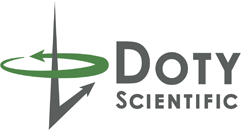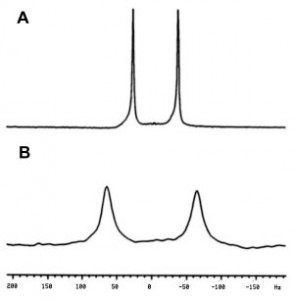Under Development:
Switched Angle Spinning (SAS) with PFG
A new look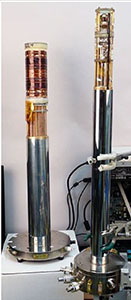 at SAS: SAS with a 3 axis PFG coil.
at SAS: SAS with a 3 axis PFG coil.
With the SAS-PFG probe that we are developing, there is new need for multi-axis gradients, where it will be useful to be able to generate gradients along the spinning axis at the magic angle and at other angles.
Left: Photo showing the new, completed, triple-resonance SAS probe (on the right) and the 3 axis PFG gradient coil. The gradient coil fits inside standard WB high-field magnet shim bores (73 mm ID). The SAS probe (46.5 mm OD) slides inside the gradient coil.
Below: Three views of the Doty triple-resonance 500 MHz SAS Probe

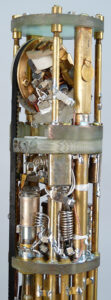
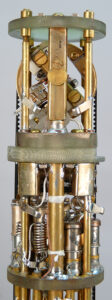
Click here to see the poster presented at the ENC in 2021.
Switched Angle Spinning (SAS) Probes
One of the more promising additions to the arsenal of NMR tools has been the use of long-range constraints from residual dipolar couplings in partially aligned solutions. Partial macromolecule alignment has been obtained by using dilute liquid-crystal solutions of disc-shaped bicelles, but this alone is not sufficient for the needed dynamical control over the alignment.
High-field SAS probe for residual dipolar couplings.
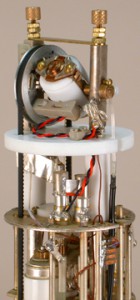 Analyses and experiments indicate novel Switched Angle Spinning ( SAS ) techniques should provide the needed dynamic control over the bicelle alignment. When a sample containing discoidal bicelles of negative magnetic anisotropy is spun at the Magic Angle, their interaction with B0 vanishes and their orientation becomes random. For sample spinning at angles less than 54.7° , they align with their normals perpendicular to the spinning axis, while spinning at greater angles causes their normals to align with the spinning axis. The dynamic control over the spinning axis provided by a SAS probe may provide the protein alignment control needed for more effective utilization of the bond angle information inherent in the residual dipolar coupling.
Analyses and experiments indicate novel Switched Angle Spinning ( SAS ) techniques should provide the needed dynamic control over the bicelle alignment. When a sample containing discoidal bicelles of negative magnetic anisotropy is spun at the Magic Angle, their interaction with B0 vanishes and their orientation becomes random. For sample spinning at angles less than 54.7° , they align with their normals perpendicular to the spinning axis, while spinning at greater angles causes their normals to align with the spinning axis. The dynamic control over the spinning axis provided by a SAS probe may provide the protein alignment control needed for more effective utilization of the bond angle information inherent in the residual dipolar coupling.
Our 1HMAX ( inner cross coil) MAS probes have allowed VAS (Variable Angle Spinning) and SAS (Switched Angle Spinning) in wide-bore probes since 1997. The two-coil MAS technology offers an order of magnitude reduction in decoupler heating. In response to the new applications for SAS, we have developed a SAS probe with more durable, fatigue-resistant leads (for up to 500,000 flips before replacement), faster switching and improved 1H S/N. Precise computer control of angle setting (via a servo motor) results in magic angle setting reproducibility during SAS of >0.015°, with a 60 ms settling time. Tuning can be H/X or H/X/Y with 3, 4, or 5 mm spinners. The first of these new SAS probes was delivered in June 2003. VAS (Variable Angle Spinning, 0° to 90°, manual control) and SAS (Switched Angle Spinning, 0° to 90°, with servo/computer control) are currently available only on the widebore XC MAS probe.
